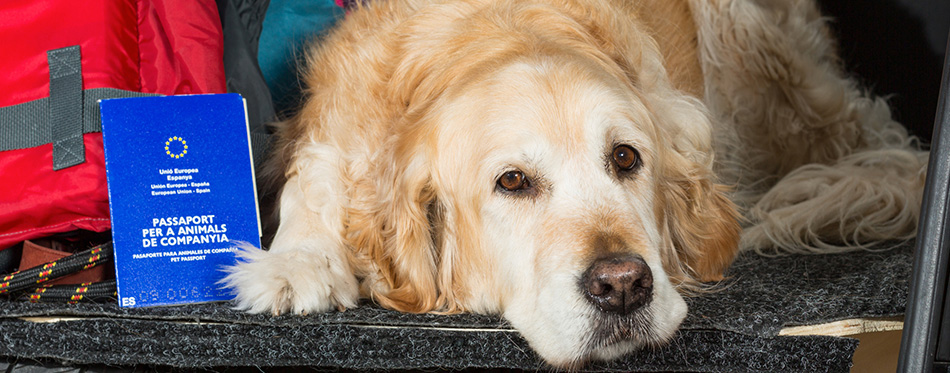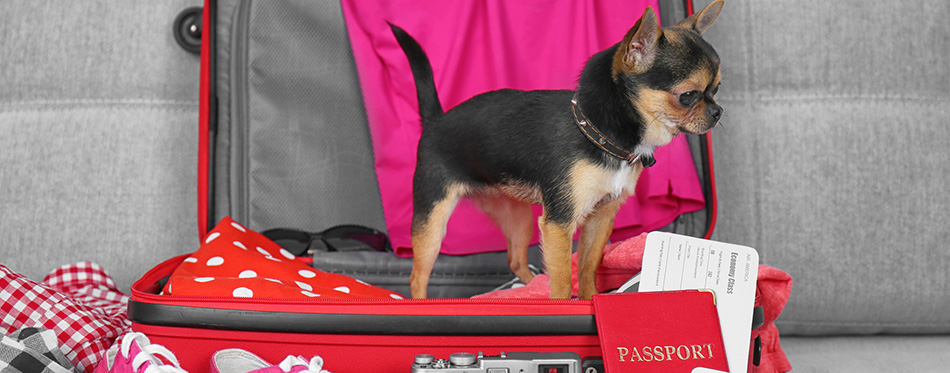Going on a much-needed holiday with your pet requires careful preparation. This can start several months before the actual date of travel. If your holiday involves traveling to another country, you will need to prepare various documents. Different countries will have their own requirements for traveling with pets. A pet passport is one of the more important documents that all pet parents traveling overseas have to prepare in advance. Here’s everything you need to know about this important piece of pet document.

The Pet Passport
By definition, a passport is an official authorization allowing an entity from one country to enter another country. In the case of a pet passport, the entity here is the pet.
As such, this document contains relevant information about the pet. The pet passport contains the animal’s rabies vaccination status. It can also contain other information like worm treatments, blood tests, and tick treatments.
It is very similar to the passport that we humans possess. This document contains information regarding our personal identity. The same is true with pet passports. It contains information about the pet which the authorities of the receiving country may deem important. This will help them decide whether to allow the pet through the port or not.
The pet passport is valid for the entire lifetime of the pet. However, like all official documents, the information it contains require constant updating. This is especially true for the pet’s rabies vaccination status and other canine treatments.
Related Posts: Dog Carrier Slings and Backpack Dog Carriers
History of the Pet Passport
The pet passport has its origins in the UK in 2001. Historically-speaking, the United Kingdom is very serious about maintaining its rabies-free status. The UK is also very strict when it comes to exotic and tropical diseases that may enter British soil. Animals that enter the UK may harbor disease-carrying pests. As such, the UK government has a very strict animal quarantine program. This means all animals that enter the UK are subject to quarantine that can last up to 6 months.
It is easy to imagine the inconvenience if you’re a Briton traveling with your pet. It may be easy to travel with your dog to another country. Returning may be a different story. They will have to allow the UK government to quarantine their pet. This means temporary separation from your beloved dog, cat, or any other pet that you brought in your travel.
To address this issue, the UK government instituted the Pets Travel Scheme in 2001. The scheme allowed Britons to bring their pets with them in their overseas travels. They don’t need to worry about their pets getting quarantined upon their return.
By October 2001, other member countries of the European Union started adopting the PETS scheme. This allowed nationals and residents from these countries to travel with their pets to other member countries. There are other requirements, of course. For instance, member countries also require the use of appropriate dog carriers. This is in addition to the pet passport.
Not long after, other countries outside the UK and the European Union also adopted the PETS program. This includes the United States, Australia, Canada, New Zealand, Argentina, the UAE, and Caribbean countries.
As such, if you travel to any of these countries that recognize the PETS scheme you can be sure that your pet will not undergo mandatory quarantine.
What Does a Pet Passport Look Like?
The very first pet passports were not as “sophisticated” as what we have today. They resembled pink A4-sized papers that contained the pet’s tattoo number or microchip. The current pet passport resembles that of a blue booklet. It contains the following information in different sections.
- Section I
This contains information about the pet’s ownership. In the case of multiple owners, then each owner has to fill out a section. The pet passport can accommodate up to 6 different owners. This is helpful if the pet will be traveling with another person. If the pet ownership information does not coincide with the passport of the person carrying the pet at the time of travel, issues may arise.
- Section II
This section contains a description of the pet. It can include its coat color and patterns. There is also a portion where you can put a picture of your pet. However, the picture is not mandatory.
- Section III
This contains the microchip information of the pet. If the pet does not have a microchip, then the tattoo number will suffice. This contains the 15-digit microchip number and the location of the transponder on the pet’s body.
- Section IV
Section IV contains information about the authorized veterinarian issuing the pet passport. It contains the veterinarian’s name, license number, contact information, and other pertinent information. There is also a section at the bottom of the page where the veterinarian can affix his or her signature.
- Section V
This section contains information about the rabies vaccination status of the pet. It includes documentation of the rabies vaccine used including the dates of administration. This section also includes the complete name, license number, and contact information of the veterinarian who administered the rabies shots. The vet should be duly-authorized by the government issuing the pet passport.
- Sections VI to X
These sections are optional. However, it is best to accomplish these pet passport pages since there are some countries that may require the information. Section VI contains the official results of titration test for rabies antibodies. Section VII contains information about anti-echinococcus treatment. The following section, section VIII, includes treatments against other parasites. Section IX contains data for the pet’s other vaccinations. The last section includes the results of veterinary clinical examination.
As of December 2014, the UK is already using a more secure pet passport form. This comes with laminated strips as well as other advanced security features. The old style of pet passports is still valid, nevertheless.

The Importance of Rabies Vaccination Certification
The principal aim of the Pets Travel Scheme is to keep the UK free from rabies. The same is true for countries that employ the scheme in their pet travel programs. Dog bites account for more than 99% of all rabies cases around the world. Those who want to control its spread have to make sure that these animals have received their regular rabies vaccinations. The UK, EU, and other countries are strict when it comes to the enforcement of the no rabies shots – no entry policy.
The pet’s status of rabies vaccination is one of the most important information that the pet passport needs to have. It is also one of the most fundamental requirements for applying.
The rabies vaccination should be administered at least 21 days prior to the date of travel. This 21-day time frame may vary from country to country. As such, it is best to determine the specific guidelines in the country where you intend to go.
If the dog or pet received its rabies vaccination less than 21 days at the time of travel, port authorities may not allow it to enter.
Pets require rabies vaccination every year. As such, it is best to stay up-to-date with your pet’s vaccination schedule. If your pet travels with an expired rabies vaccination, then port authorities will not allow it to travel with you. This is despite the fact that its pet passport is still valid.
It is also important to have your pet microchipped before it gets its first rabies vaccination. If your pet gets the rabies vaccine before it gets microchipped, you are required to have your dog vaccinated against rabies again after microchipping.
How to Get a Pet Passport
Getting a pet passport is not that difficult. If you reside in the UK or any member country of the EU, then you only need to visit a duly-approved veterinarian. This means you cannot go to a veterinarian who is not duly-recognized by the government of the issuing country.
If you reside in the US, then you will need to obtain an EU Health Certificate from a USDA-accredited veterinarian. Understand that this certificate has a 4-month period of validity. Moreover, the travel should be within 10 days after the issuance of the EU Health Certificate. If you travel beyond this 10-day period, then you will need to secure another EU Health Certificate.
Understand that you will get the Pet Passport after you enter the UK or the EU; not before. As such, you can get the EU Health Certificate from your USDA-accredited veterinarian in the US no more than 10 days before you travel. Once you arrive at your destination in the UK or the EU, then you can apply for a pet passport.
When getting a pet passport, it is important to understand several guidelines.
- Only UK- and EU-approved veterinarians can issue pet passports.
- Only dogs or pets that are at least 12 weeks old at the time of pet passport application can apply. This correlates to the earliest age of dogs that can receive the first shot of rabies vaccine.
- Dogs receiving their rabies vaccination should wait 21 days before they can travel.
- The pet should have a microchip implanted underneath its skin prior to rabies vaccination.
How Much Does it Cost?
It is important to understand that the pet passport requires two fundamental components for it to be valid. First, it should contain the microchip information of your dog. Second, it should have proof of rabies vaccination. Only then will the EU- or UK-approved veterinarian issue you a pet passport.
Having said that, the cost of pet passport can vary from country to country. On the average you will be spending about 78 USD or £60 on the pet passport alone. The microchip can set you back by around £20 or 26 USD. For the vaccinations, this can set you back by about £33 or 43 USD. Bear in mind that there may be other treatments that the vet may require before he can issue a pet passport. These can include other treatments and clinical evaluations. As such you are looking to spend at least £113 or 147 USD.
Is a Pet Passport Universal?
It is unfortunate that having a pet passport doesn’t guarantee easy passage through the EU, the UK, and other countries that recognize the PETS scheme. For example, some countries may still require a Veterinary Health Certificate for your pet in addition to the pet passport.
There are also countries that still quarantine pets that have pet passports. This often occurs if the pet came from a country where rabies is still prevalent. Examples of countries where rabies are still very prevalent include China, Indonesia, Morocco, Turkey, Thailand, and the Philippines, among others. What this means is that the pet passport will not save your pet from mandatory quarantine if you travel from these high-rabies countries.
You may also like our articles on Airline Approved Pet Carriers and Dog Sleeping Bags.

Is it Worth Having a Pet Passport?
There are many advantages to having a pet passport, provided that it is valid.
First, it helps you move from port to port with relative ease. Immigration and border control authorities are already familiar with the nature of a pet passport. They feel a lot more confident about letting your pet into the country. They know your pet has all the required shots not to introduce diseases into the country.
Second, it is a lot cheaper than leaving your pet in a boarding kennel. You can also opt to hire a pet sitter to take care of your pet while you’re on a holiday. This can set you back by as much as £200 to £300 or 259 to 389 USD every holiday. Compare this with the cost of getting a pet passport and you’ll see why it’s more practical to get one. It is important to understand that the pet passport is valid for your pet’s lifetime. Except for the annual vaccinations, it only entails one-time cost.
Traveling with your pet requires you to be ready for any eventuality. Passing through ports can be daunting if you don’t have the proper documentation for your pet. Having a valid pet passport makes everything easy.

